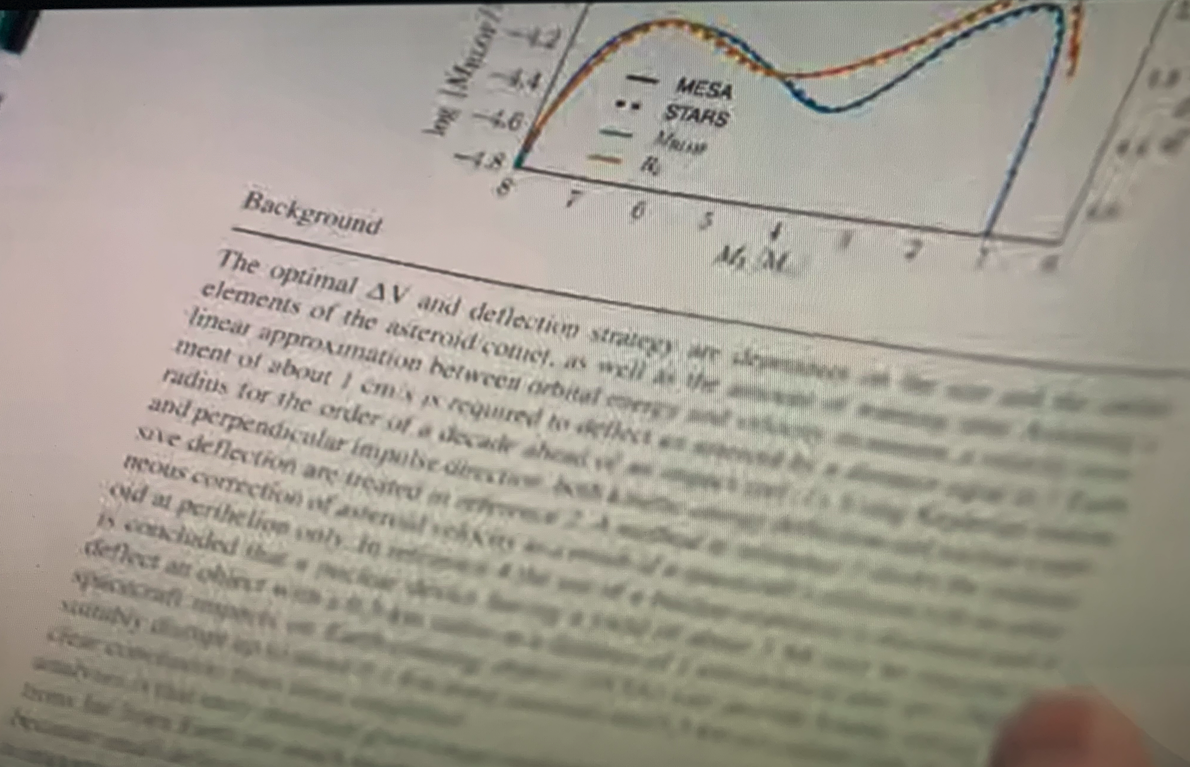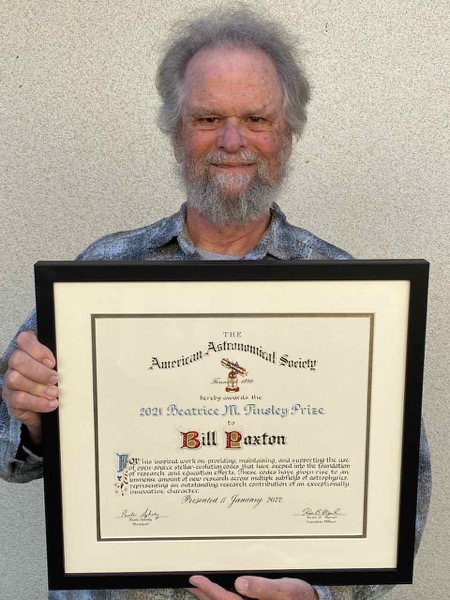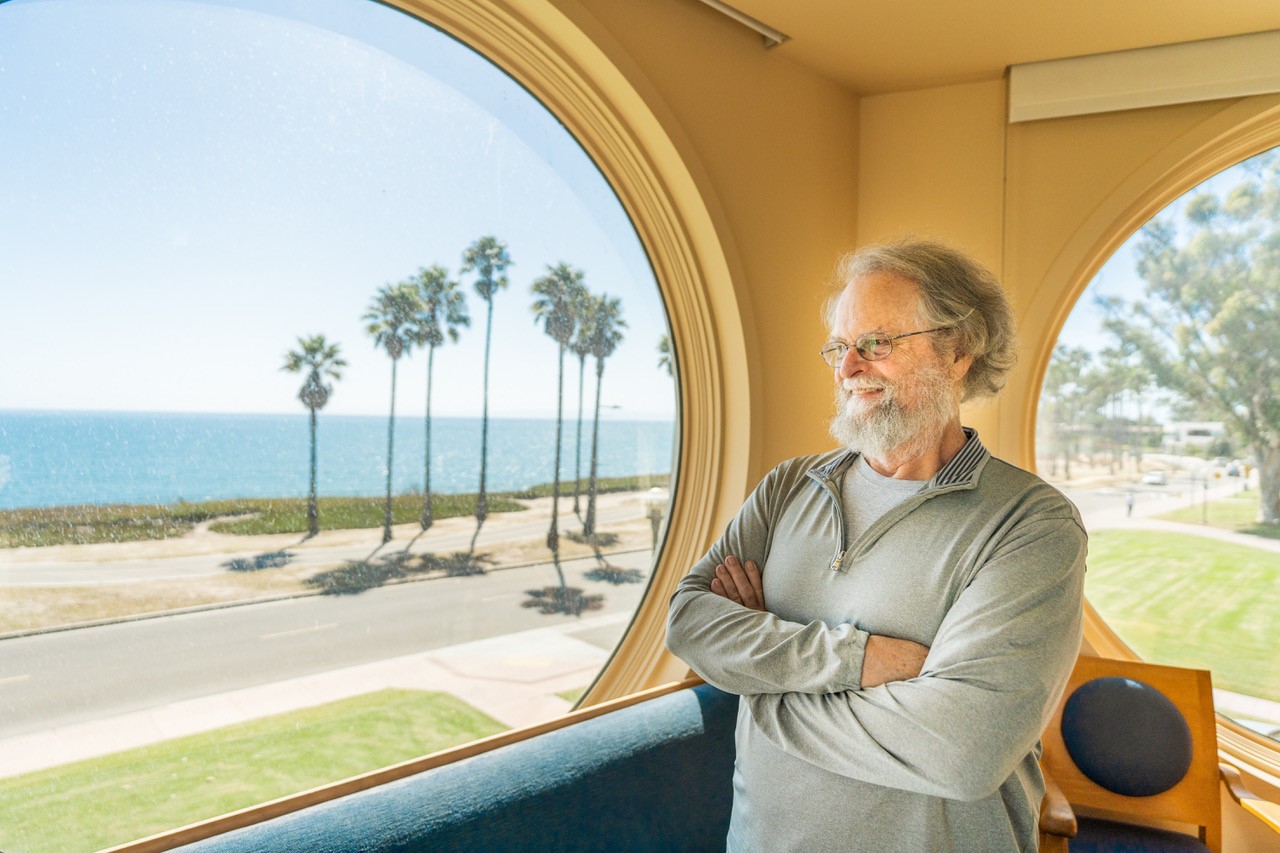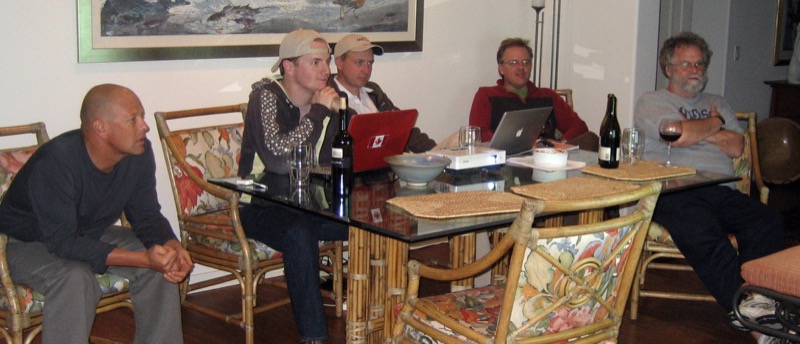
|
Cococubed.com
|
| The MESA Project |
Home
Astronomy research
Software Infrastructure:
MESA
FLASH-X
STARLIB
MESA-Web
starkiller-astro
My instruments
Neutrino Emission:
Neutrinos from de-excitation
Neutrino emission from stars
Identifying the Pre-SN
Neutrino HR diagram
Pre-SN Beta Processes
Pre-SN neutrinos
White dwarf pulsations:
12C(α,γ) & overshooting
Probe of 12C(α,γ)16O
Impact of 22Ne
Impact of ν cooling
Variable white dwarfs
MC reaction rates
Micronovae
Novae
White dwarf supernova:
Stable nickel production
Remnant metallicities
Colliding white dwarfs
Merging white dwarfs
Ignition conditions
Metallicity effects
Central density effects
Detonation density
Tracer particle burning
Subsonic burning fronts
Supersonic fronts
W7 profiles
Massive stars:
Pop III with HST/JWST
Rotating progenitors
3D evolution to collapse
MC reaction rates
Pre-SN variations
Massive star supernova:
Yields of radionuclides
26Al & 60Fe
44Ti, 60Co & 56Ni
SN 1987A light curve
Constraints on Ni/Fe
An r-process
Effects of 12C +12C
Neutron Stars and Black Holes:
Black Hole spectrum
Mass Gap with LVK
Compact object IMF
He burn neutron stars
Stars:
Hypatia catalog
SAGB stars
Nugrid Yields I
He shell convection
BBFH at 40 years
γ-rays within 100 Mpc
Iron Pseudocarbynes
Pre-Solar Grains:
C-rich presolar grains
SiC Type U/C grains
Grains from massive stars
Placing the Sun
SiC Presolar grains
Chemical Evolution:
Radionuclides in 2020s
Zone models H to Zn
Mixing ejecta
Thermodynamics, Opacities & Networks
Radiative Opacity
Skye EOS
Helm EOS
Five EOSs
Equations of State
12C(α,γ)16O Rate
Proton-rich NSE
Reaction networks
Bayesian reaction rates
Verification Problems:
Validating an astro code
Su-Olson
Cog8
Mader
RMTV
Sedov
Noh
Software Instruments
2026 AAS Journals
AAS YouTube
Listing of 500+ Author Videos
AAS Peer Review Workshops
Outreach Material
Education Material
Other Stuff:
Bicycle Adventures
Illustrations
Presentations
Contact: F.X.Timmes
my one page vitae,
full vitae,
research statement, and
teaching statement.

|

|
MESA VI is awarded a Top 1% most cited article from IOP publishing

|
Bill Paxton (1946-2025)
with an email, as we began it:
hi bill,
i will miss your smile most of all. your memory is a blessing to me.
what a fantastic journey my friend. we will get that 40 years of MESA!
fxt
 Accidental Astrophysicist A Revolution Image Credit: Matteo Cantielo, Feb 2024 |
31Mar2025 MESA moves to the Flatiron Institute!
The happy announcement from the Simons Foundation.
Modules for Experiments in Stellar Astrophysics: Time-Dependent Convection, Energy Conservation, Automatic Differentiation, and Infrastructure - MESA ⅤⅠ, 2023
In this article, we update the capabilities of the open-knowledge software instrument Modules for Experiments in Stellar Astrophysics (MESA). The new auto_diff module implements automatic differentiation in MESA, an enabling capability that alleviates the need for hard-coded analytic expressions or finite difference approximations. We significantly enhance the treatment of the growth and decay of convection in MESA with a new model for time-dependent convection, which is particularly important during late-stage nuclear burning in massive stars and electron degenerate ignition events. We strengthen MESA's implementation of the equation of state, and we quantify continued improvements to energy accounting and solver accuracy through a discussion of different energy equation features and enhancements. To improve the modeling of stars in MESA, we describe key updates to the treatment of stellar atmospheres, molecular opacities, Compton opacities, conductive opacities, element diffusion coefficients, and nuclear reaction rates. We introduce treatments of starspots, an important consideration for low-mass stars, and modifications for superadiabatic convection in radiation-dominated regions. We describe new approaches for increasing the efficiency of calculating monochromatic opacities and radiative levitation, and for increasing the efficiency of evolving the late stages of massive stars with a new operator split nuclear burning mode. We close by discussing major updates to MESA's software infrastructure that enhance source code development and community engagement.

TDC schematic |

EOS regions |

Tests Submitted |
|
MESA appears in the Netflix movie "Don't Look Up" - 2022
First noted by Jared Goldberg on his Twitter feed, a lovely ApJ Supplement figure makes an appearance at about the 1 hr 11 min mark:
Here is the relevant page in the movie's mashup "report":

How and Why figure 4 of MESA III figure appears in the movie is a story itself. Thank you Amy Mainzer!
Tinsley Prize - 2021
Bill Paxton was awarded the 2021 Beatrice M. Tinsley Prize "for his inspired work on providing, maintaining, and supporting the use of open-source stellar-evolution codes that have seeped into the foundation of research and education efforts and have given rise to an immense amount of new research across multiple subfields of astrophysics." The Tinsley Prize, awarded every two years by the American Astronomical Society, recognizes an outstanding research contribution to astronomy or astrophysics of an exceptionally creative or innovative character.
Thank you Bill!

|

|
Modules for Experiments in Stellar Astrophysics: Pulsating Variable Stars, Rotation, Convective Boundaries, and Energy Conservation - MESA Ⅴ, 2019
In this paper, we update the capabilities of the open-knowledge software instrument Modules for Experiments in Stellar Astrophysics (MESA). RSP is a new functionality in MESAstar that models the nonlinear radial stellar pulsations that characterize RR Lyrae, Cepheids, and other classes of variable stars. We significantly enhance numerical energy conservation capabilities, including during mass changes. For example, this enables calculations through the He flash that conserve energy to better than 0.001%. To improve the modeling of rotating stars in MESA, we introduce a new approach to modifying the pressure and temperature equations of stellar structure, as well as a formulation of the projection effects of gravity darkening. A new scheme for tracking convective boundaries yields reliable values of the convective core mass and allows the natural emergence of adiabatic semiconvection regions during both core hydrogen- and helium-burning phases. We quantify the parallel performance of MESA on current-generation multicore architectures and demonstrate improvements in the computational efficiency of radiative levitation. We report updates to the equation of state and nuclear reaction physics modules. We briefly discuss the current treatment of fallback in core-collapse supernova models and the thermodynamic evolution of supernova explosions. We close by discussing the new MESA Testhub software infrastructure to enhance source code development.

Nonlinear pulsations |

He flash and gold tolerances |

Equipotentials of Roche potential |

Grad profiles with CPM |
Modules for Experiments in Stellar Astrophysics: Convective Boundaries, Element Diffusion, and Massive Star Explosions - MESA Ⅳ, 2018
In this paper, we update the capabilities of the software instrument Modules for Experiments in Stellar Astrophysics (MESA) and enhance its ease of use and availability. Our new approach to locating convective boundaries is consistent with the physics of convection, and yields reliable values of the convective core mass during both hydrogen and helium burning phases. Stars with M < 8 Msun become white dwarfs and cool to the point where the electrons are degenerate and the ions are strongly coupled, a realm now available to study with MESA due to improved treatments of element diffusion, latent heat release, and blending of equations of state. Studies of the final fates of massive stars are extended in MESA by our addition of an approximate Riemann solver that captures shocks and conserves energy to high accuracy during dynamic epochs. We also introduce a 1D capability for modeling the effects of Rayleigh-Taylor instabilities that, in combination with the coupling to a public version of the STELLA radiation transfer instrument, creates new avenues for exploring Type II supernovae properties. These capabilities are exhibited with exploratory models of pair-instability supernova, pulsational pair-instability supernova, and the formation of stellar mass black holes. The applicability of MESA is now widened by the capability of importing multi-dimensional hydrodynamic models into MESA. We close by introducing software modules for handling floating point exceptions and stellar model optimization, and four new software tools - MESA-Web, MESA-Docker, pyMESA, and mesastar.org - to enhance MESA's education and research impact.

Sedov |

Entropy Trail |

H shell flash on He WD |
Modules for Experiments in Stellar Astrophysics: Binaries, Pulsations, and Explosions - MESA Ⅲ, 2015
In this paper, we substantially update the capabilities of the open-source software instrument Modules for Experiments in Stellar Astrophysics (MESA). MESA can now simultaneously evolve an interacting pair of differentially rotating stars undergoing transfer and loss of mass and angular momentum, greatly enhancing the prior ability to model binary evolution. New MESA capabilities in fully coupled calculation of nuclear networks with hundreds of isotopes now allow MESA to accurately simulate advanced burning stages needed to construct supernova progenitor models. Implicit hydrodynamics with shocks can now be treated with MESA, enabling modeling of the entire massive star lifecycle, from pre-main sequence evolution to the onset of core collapse and nucleosynthesis from the resulting explosion. Coupling of the GYRE non-adiabatic pulsation instrument with MESA allows for new explorations of the instability strips for massive stars while also accelerating the astrophysical use of asteroseismology data. We improve treatment of mass accretion, giving more accurate and robust near-surface profiles. A new MESA capability to calculate weak reaction rates "on-the-fly" from input nuclear data allows better simulation of accretion induced collapse of massive white dwarfs and the fate of some massive stars. We discuss the ongoing challenge of chemical diffusion in the strongly coupled plasma regime, and exhibit improvements in MESA that now allow for the simulation of radiative levitation of heavy elements in hot stars. We close by noting that the MESA software infrastructure provides bit-for-bit consistency for all results across all the supported platforms, a profound enabling capability for accelerating MESA's development.

16 M☉ + 14 M☉ binary |

Instability strips |

1.57×1051 erg explosion |
Modules for Experiments in Stellar Astrophysics: Giant Planets, Oscillations, Rotation, and Massive Stars - MESA Ⅱ, 2013
In this paper, we substantially update the capabilities of the open source software package Modules for Experiments in Stellar Astrophysics (MESA), and its one-dimensional stellar evolution module, MESAstar. Improvements in MESAstar's ability to model the evolution of giant planets now extends its applicability down to masses as low as one-tenth that of Jupiter. The dramatic improvement in asteroseismology enabled by the space-based Kepler and CoRoT missions motivates our full coupling of the ADIPLS adiabatic pulsation code with MESAstar. This also motivates a numerical recasting of the Ledoux criterion that is more easily implemented when many nuclei are present at non-negligible abundances. This impacts the way in which MESAstar calculates semi-convective and thermohaline mixing. We exhibit the evolution of 3-8 Msun stars through the end of core He burning, the onset of He thermal pulses, and arrival on the white dwarf cooling sequence. We implement diffusion of angular momentum and chemical abundances that enable calculations of rotating-star models, which we compare thoroughly with earlier work. We introduce a new treatment of radiation-dominated envelopes that allows the uninterrupted evolution of massive stars to core collapse. This enables the generation of new sets of supernovae, long gamma-ray burst, and pair-instability progenitor models. We substantially modify the way in which MESAstar solves the fully coupled stellar structure and composition equations, and we show how this has improved MESA's performance scaling on multi-core processors. Updates to the modules for equation of state, opacity, nuclear reaction rates, and atmospheric boundary conditions are also provided. We describe the MESA Software Development Kit (SDK) that packages all the required components needed to form a unified and maintained build environment for MESA.

Giant planet evolution |

Echelle diagram of HD43985. |

Magnetic field and angular momentum |
Modules For Experiments In Stellar Astrophysics - MESA Ⅰ, 2011
In this paper, we describe Modules for Experiments in Stellar Astrophysics (MESA), a suite of open source, robust, efficient, thread-safe libraries for a wide range of applications in computational stellar astrophysics. A one-dimensional stellar evolution module, MESAstar, combines many of the numerical and physics modules for simulations of a wide range of stellar evolution scenarios ranging from very low mass to massive stars, including advanced evolutionary phases. MESAstar solves the fully coupled structure and composition equations simultaneously. It uses adaptive mesh refinement and sophisticated timestep controls, and supports shared memory parallelism based on OpenMP. State-of-the-art modules provide equation of state, opacity, nuclear reaction rates, element diffusion data, and atmosphere boundary conditions. Each module is constructed as a separate Fortran 95 library with its own explicitly defined public interface to facilitate independent development. Several detailed examples indicate the extensive verification and testing that is continuously performed and demonstrate the wide range of capabilities that MESA possesses. MESA can be downloaded from the project Web site https://docs.mesastar.org

Equation of State |

Opacity |

Massive stars in ρ-T plane |
Dawn of a Revolution - 2010
In 2010 stellar evolution software instruments were closed source, closed knowledge, unsupported, and concentrated in ~10 locations around the world. Yet stellar astronomy was (and still is) booming with new observations, new puzzles, and new science. There was a huge pent-up demand for new stellar models. The opportunity for a revolution was ripe ...

MESA I Instrument Paper writing in Sep2010. Image by Kathlyn Paxton, just before the Manifesto in Appendix A. |
An email on 08Jan2005 that changed my life:
Hello, my name is Bill Paxton. May I please use the tools posted on your website?
| Title | What, When, and Where |
| ☆ MESA Marketplace | Aggregator site |
| ☆ 2025 MESA Summer School | 21Jul- 25Jul, Leuven |
| ☆ 2024 MESA Down Under | 17Jun - 21Jun, Sydney |
| ☆ 2023 MESA Summer School | 28Aug - 01Sep, Konkoly |
| ☆ 2022 MESA Summer School | Aug 8-12, 2022, UCSB |
| ☆ 2021 MESA Summer School | Aug 9-20, 2021, Online |
| ☆ 2020 MESA Summer School | Aug 10-14, 2020, Cancelled |
| ☆ 2019 MESA Summer School | Aug 12-16, 2019, UCSB |
| ☆ 2018 MESA Summer School | Aug 13-17, 2018, UCSB |
| ☆ Simulating Stars: From Theory to Observations | June 25-29, 2018, Beijing |
| ☆ 2017 MESA Summer School | Aug 14-18, 2017, UCSB |
| ☆ 2016 MESA Summer School | Aug 15-19, 2016, UCSB |
| ☆ 2015 MESA Summer School | Aug 10-14, 2015, UCSB |
| ☆ 2014 MESA Summer School | Aug 11-15, 2014, UCSB |
| ☆ 2013 MESA Summer School | Aug 12-16, 2013, UCSB |
| ☆ 2012 MESA Summer School | Aug 13-17, 2012, UCSB |

|

|

|

|

|

|